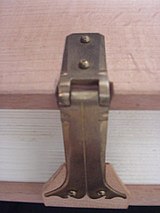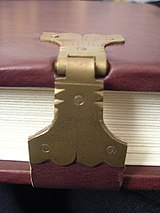Book clasp

|

|
|
|
Metal clasps:
ribbon with alchemical treatises (bound in Strasbourg around 1568, collection of the Chemical Heritage Foundation , Philadelphia) |
Book clasps are leather or metal construction elements, especially those of the medieval and early modern book cover , which were used to protect the book block from blocking and thus the ingress of dust and light. The book can also be pulled out of the shelf if the back, as was common in the Middle Ages and partly in the early modern period, points backwards. Even so could a book from unauthorized disclosure by lockable closing or locks , or housed in the book cover as a padlock to be protected.
history
Medieval book bindings had solid spines , which means that the book block and the binding material were firmly connected to one another at this point. Despite the weight of the wooden book cover , it was inevitable that the cover and the mostly still parchment layers built up a tension that caused the book, which was kept lying flat, to gape open. When the parchment was replaced by paper as book pages, the need to close the book remained, as the slightly curved wooden cover and the tensile strength of the cover materials always encourage the book to unlock. The book clasps were therefore developed from the logical consequence of having to build up a corresponding counter pressure through their tensile force. As with the book fittings , however, a decorative function quickly joined the protective function.
The clasps remained an integral part of many books until the 16th century. In Italy and France at this time book covers without clasps were already developing, the overall design of which represented a special expression of the educated bourgeoisie. While in Central Europe two clasps on the front cut were common, in Italy or in regions influenced by Italian bindings an additional head and foot cut were added. The possibilities for designing clasps were diverse. Luxury bindings were usually adorned with precious metal clasps, the decoration of which was based on the fittings. Utility bindings, on the other hand, usually had simple brass clasps with leather or metal hinges, which, especially those coming from Nuremberg, were sold in large parts of the German-speaking cultural area.
With the advent of cardboard lids, metal clasps were occasionally replaced with leather straps or fabric straps. But this handle survived quickly. The increasingly prevalent storage of books on shelves made closures or related elements superfluous from the 17th century at the latest. Together with the fittings, they have therefore often been removed in modern times for more efficient storage . Only a few books were still provided with closures, such as prayer books and the like to take with you on trips; In many books of this type, especially from the period of historicism , the decorative function predominated.
Closures now only exist in exceptional cases, for example in diaries. The focus here is on protecting the content from unauthorized reception and not the material of the book block.
variants

Codex Forster III , Leonardo da Vinci's notebook in the original cover (around 1493–1496, Victoria and Albert Museum , London)
The cover research distinguishes seven different types of Close Construction:
- Long strap clasps made of leather , which are led around the book and fastened there.
- As a variant of the first construction: long belt fasteners that are attached to overlapping parchment or leather flaps (common with Kopert or filing volumes).
- Leather or parchment straps that close the book in itself by wrapping and knotting.
- Leather or parchment ribbons that are looped around buttons on the front cover or back (especially common in copters).
- Braided leather straps (Greece, Spain and Italy)
- Leather clasp with metal fittings or leather hinge.
- Metal clasps with metal hinge.
- Closing with lock
literature
- Georg Adler: Manual book closure and book fitting: terminology and history in the German-speaking area, in the Netherlands and Italy from the early Middle Ages to the present day . Wiesbaden: Reichert, 2010 ISBN 978-3-89500-752-1 .
- Claus Maywald: The book closures, book fittings and other metal parts on the book. The terminology. Wiegner, Königswinter 2005, ISBN 3-931775-10-0 .
- Eike Barbara Dürrfeld: Research into book clasps and book fittings. An analysis of the history of science since 1877. Dissertation, Mainz 2002, online (PDF; 12.8 MB) .
- Agnes Bettina Hokyong Scholla: Libri sine asseribus. On the binding technique, form and content of medieval coperts from the 8th to 14th centuries. Dissertation, Leiden 2001.
- Otto Mazal : Binding customer. The history of the book cover (= elements of the book and library system 16). Ludwig Reichert Verlag, Wiesbaden 1997, ISBN 3-88226-888-3 , SS 23.
- J. Vezin: book closing. In: Severin Corsten (Ed.): Lexicon of the entire book system. Volume 1: A-book. Hiersemann, Stuttgart 1987, ISBN 3-7772-8721-0 , p. 633.
- Hellmuth Helwig: Introduction to Binding. Hiersemann, Stuttgart 1970, ISBN 3-7772-7008-3 . P. 35f.
- Roland Hartmann: Lockable bindings of the 15th and 16th centuries , in: Festschrift Otto Schäfer for his 75th birthday on June 29, 1987 , ed. by Manfred von Arnim, Stuttgart 1987, pp. 427-436.
Web links
- Book clasps and book fittings from the holdings of the Baltika Department of the Academic Library of Tallinn University. Restoration Department of the Academic Library at Tallinn University , accessed April 7, 2017 .
- Marco Heiles: List of lockable manuscripts from the Middle Ages and the early modern period. In: Mittelalter.hypotheses.org. April 4, 2017. Retrieved April 7, 2017 .
Individual evidence
- ↑ Marco Heiles: List of lockable manuscripts from the Middle Ages and the early modern period. September 17, 2016, accessed November 4, 2016 .

